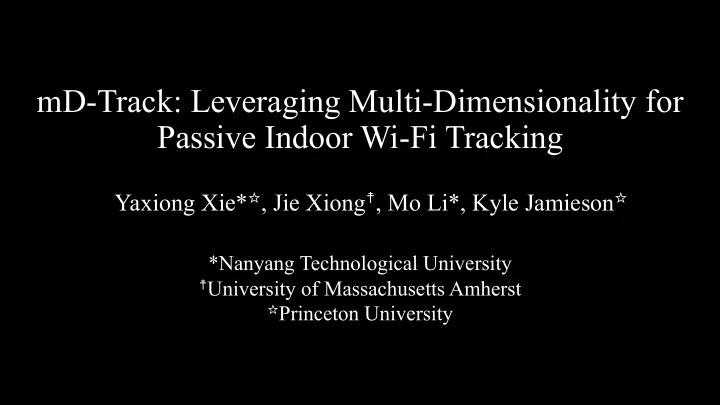

mD-Track: Leveraging Multi-Dimensionality for Passive Indoor Wi-Fi Tracking Yaxiong Xie* ☆ , Jie Xiong ☨ , Mo Li*, Kyle Jamieson ☆ *Nanyang Technological University ☨ University of Massachusetts Amherst ☆ Princeton University
Wi-Fi Sensing Ø Wi-Fi sensing enables diverse applications Sender HCI interface Human tracking Human Receiver Respiration monitoring Proximity advertising
Why Wi-Fi sensing is possible?
The signal changes with target movements Transmitter Propagation channel Receiver
The signal changes with target movements Transmitter Propagation channel Receiver
The signal changes with target movements Transmitter Propagation channel Receiver
Target reflections Ø The target-reflected signal carries the information about the target Obstacles Wi-Fi AP Mobile devices Human Wall Human target 1 target 2
A fundamental task in wireless sensing Retrieve the target-reflected signal which contains the context information of the target 8
Challenge Ø The reflected signals from multiple targets are mixed together with direct path and other reflection signals Ø It’s challenging to separate the signals due to limited channel bandwidth (40MHz) and limited number (3- 4) of antennas at the Wi-Fi access point 9
Separating two signals Resolvability presents us the capability of separating two signals
Spatial domain separation Ø Signals can be separated in spatial domain with angle-of-arrival (AoA) information -0.6 -0.3 -0.3 0 0 180 0 Ø AoA resolvability is determined by the number of antennas in the 30 150 array 120 60 90 Ø More antennas result in higher resolvability
Time domain separation Ø Signals can also be separated in time domain with time-of-flight (ToF) information Ø ToF resolvability is determined by the signal channel bandwidth Ø Wider bandwidth results in higher resolvability Signal from phone Signal from chair ToF 2 ToF 1 time
The Wi-Fi sensing performance is fundamentally limited by signal resolvability
How to improve the resolvability of Wi- Fi signals without any hardware modifications?
The power of multi-dimensionality Two signals are close in time domain but far away in spatial domain 𝝊 𝟐 𝑻 𝟐 𝝔 𝟐 Angle of Arrival 𝑻 𝟑 𝑻 𝟐 𝝔 𝟑 𝝊 𝟑 𝑻 𝟑 Transmitter Receiver Time of Flight
The power of multi-dimensionality Two signals are close in spatial domain but far away in 𝝊 𝟑 time domain 𝝔 𝟑 𝑻 𝟑 𝝊 𝟐 𝑻 𝟐 𝝔 𝟐 Angle of Arrival 𝑻 𝟐 𝑻 𝟑 Transmitter Receiver Time of Flight
The power of multi-dimensionality Two signals close in both spatial and time domain can be separated in frequency domain 𝜹 (Doppler shift) 𝑻 𝟑 𝝊 𝟐 𝑻 𝟐 𝝔 𝟐 Doppler Shift 𝑻 𝟐 Time of Flight Transmitter Receiver Angle of Arrival 𝑻 𝟑
The power of multi-dimensionality Multi-dimensional information helps separate close-by signals !
Combining information from multi-dimensions AoA, AoD, ToF and Doppler shift for signal separation
What can be achieved? Ø More accurate sensing Ø Multi-target sensing (a well known challenge for passive sensing) Ø Larger sensing range
Joint estimation for a single path signal Please refer to our paper for more details!
Joint estimation for multiple signals Single-path signal Multiple signals Noise Signal Signal 1 Signal 2 Noise
Joint estimation for multi-path signals Successive Interference Cancellation Single path 𝒏 - dimensional estimator Noise Signal Signal parameter 𝝔, 𝝌, 𝝊, 𝜹
Joint estimation for multi-path signals Successive Interference Cancellation Single path 𝒏 - dimensional estimator Noise Signal Signal parameter Reconstruction 𝝔, 𝝌, 𝝊, 𝜹 Reconstructed signal
Joint estimation for multi-path signals Successive Interference Cancellation Noise Signal Reconstructed signal
Joint estimation for multi-path signals Successive Interference Cancellation Single path 𝒏 - dimensional estimator Signal Noise Signal parameter 𝝔, 𝝌, 𝝊, 𝜹
Reduce the computational load Ø Computation overhead • EM algorithm adopted is computational intensive • We apply Generalized EM algorithm (SAGE) to reduce the computational overhead Please refer to our paper for more details!
Performance Evaluation
Testbed Ø We implement our system on both WARP and commodity Wi-Fi AP • WARP supports 8 antennas • WPJ558 and TP-Link 4300 Wi-Fi AP are equipped with 3 antennas
Resolvability Ø We achieve 20 times higher resolvability compared to the state-of-arts MUSIC and SpotFi algorithm
Passive localization Commercial Wi-Fi AP WARP mD-Track 4D achieves a median error of 0.28m mD-Track 4D achieves a median error of 0.48m with 8 antennas and 40MHz bandwidth with 3 antennas and 40MHz bandwidth
Motion tracking Ø Two target moving at the same time We can separate the movements of two close-by fingers!
Conclusions Ø MD-Track addresses one fundamental problem in wireless sensing Ø MD-Track is not limited to localization but can be applied to a large range of sensing applications Ø MD-Track can be employed for sensing with other wireless technologies such as RFID, acoustic and mmWave
Recommend
More recommend